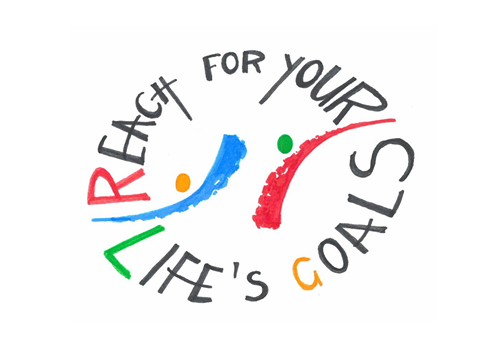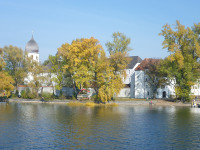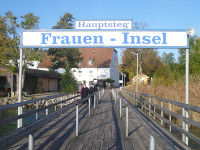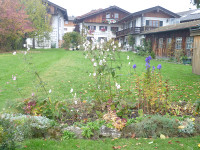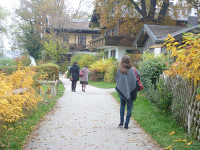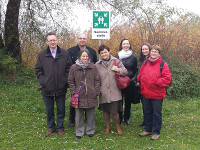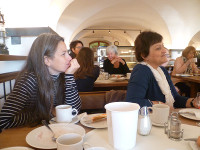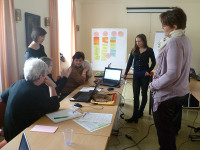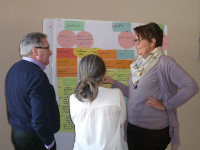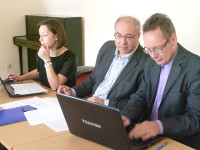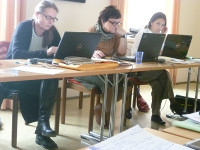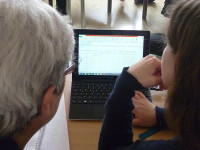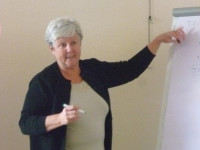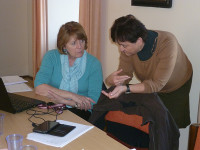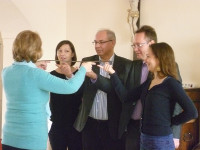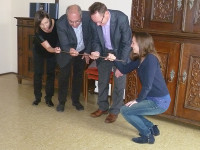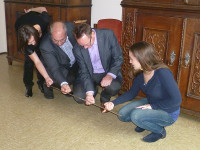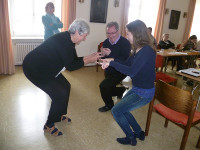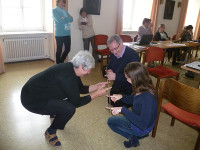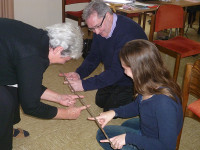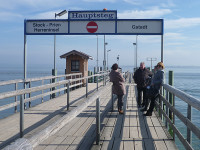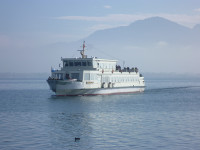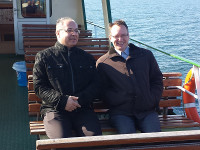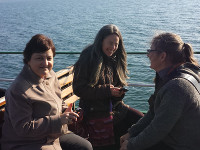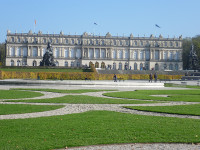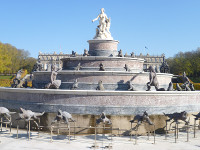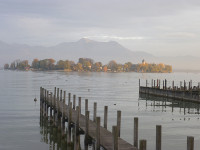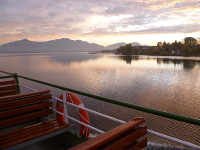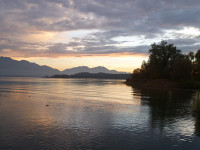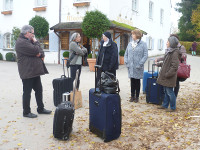October 2015, Munich
The fifth partner meeting again took place in Germany, between 26 and 29 October 2015. The German partners did not organize the meeting at their usual place in the ETC building in Munich but arranged it at a place not far from the city which provided the opportunity to work in peaceful surroundings, close to nature. This place is located on a small island named Fraueninsel in the middle of lake Chiemsee, where the local convent hosted us in their guest houses. The peaceful conditions of the island created an excellent environment for intensive work. The meeting took place over three days and the programme started by the partners presenting the project events of each country.
The Polish partners finished the first Assessment Day a few days earlier which had been preceded by a preparation programme for trainers. They informed us of how much of the RLG programme they have managed to translate into Polish. Both Polish teachers and students were open to accepting the program. Their student group consisted of 13 girls and they were inquisitive and actively cooperated with the trainers. After finishing each exercise they had good discussions and willingly gave feedback, which was qualified as being between 'good' or 'excellent'. The participants enjoyed the nature of the activities which were very different from their usual school practice. The Polish partners informed us about starting a second test group in a vocational school not far from Cracow.
The ETC presentation informed the participants about the final interviews which had been carried out with the members of the German test group, and have provided an overview of the process since summer 2015. It was generally believed that the young people had enjoyed the programme and they considered that they had learned something new. It can be taken as an important result that a number of young people said: “we have learned about working to implement our goals and not give up”; “now it is much easier to cooperate with others than it was earlier and we do enjoy doing so”. The summarized data from the self-assessment questionnaires was distributed in printed form among the participants.
The other focal point of the German presentation was to try out the exercises of the Assessment Day with three additional groups during the last week of September. As previously, the German colleagues gave feedback on how the participants had accepted the various units exercise by exercise. They concluded that it was difficult to harmonize the roles of trainers and observers. They have informed us that they had met with the members of the former group as part of the follow up process. They started a new test process of RFG training in the middle October and are planning to prepare new trainers in November.
The Scottish partners shared their experiences of the follow-up stage of the programme. They have met twice with the young people participating in the test courses and had the impression that the program has perceptibly and positively influenced the majority. They found only one boy that did not show perceptible changes as compared with his earlier situation.
They informed us that the management of their partner school had been recently changed and this has resulted in a delay in starting the second group, although the school management still supports the project. They believe that the composition of the new group might be different from the first group as the school management thinks that participation in the course might be important for a wider group, not just for those with low educational achievement.
The programme fits well into the focus within Scottish education on supporting young people into the world of work through gaining work experience. The Scottish partners believe it would be useful to link the RLG program with a work experience placement. They noted that they would offer additional secondary schools in Stirling the opportunity to participate and would start preparing a few external trainers. They plan to start a new group in January and intend to hold the Assessment Day in December.
The Hungarian partners gave an overview of the most important issues concerning the assessment of the Interim Report. They informed their partners about the experiences of the two Hungarian test groups. The idea was raised of adding a mark to the exercises which would show the level of difficulty – after having realized the problems of literacy and concentration of the young people staying in reformatories. To put it in a flexible way: it would be useful to elaborate the exercises at various levels.
The partners briefly outlined the trend of transforming the system of vocational training taking place in Hungary and noted it was still unclear where to find linking points for the RLG program. The participants have made contact with several vocational institutions in order to try out the tools of assessment and measurement. If the schools consider it a possibility they will use the training materials, as well. The Hungarian partners were pleased to inform the group that the trainer of a test group will continue the program in his own right in the springtime.
During the presentations the participants had a number of particular issues which generated vivid discussions – most of them concerning the Assessment Day. The most important ones were as follows:
- Would it be useful to inform the young people about their results and share the observers' experiences concerning the learners' skills when carrying out the exercises during the Day of Assessment? Or would it be better not to share any information with them about the details. The participants produced arguments pro and contra but at the end they accepted the argument that it is better to offer a clear picture for the young people about their achievements, since this is more likely to be to their advantage. They considered that the results of the Assessment Day did not equal 'low grades' but rather reflected a specific situation at a given time. The learners may decide whether to accept the situation or try to change it, and if they take the latter choice they can rely on the trainers' support.
- Would it be useful to implement the Assessment Day in one block or rather divide its management into two units? The participants argued for the first version saying it informs them about the workload the young people will face in the workplace throughout the day. The representatives of the second version emphasized that the assessment process should be held on two afternoons to better fit into the institutional rhythm of schools, and the learners become less tired by this.
- Would it be appropriate to ask the colleagues running the exercises to observe the young people or is it better to separate the two types of roles of the Assessment Day? Experiences demonstrate that the quality of assessment rises if the roles are separated and more observers participate in the program. This means that preparing observers is becoming a separate task of the programme as part of the training process of experts.
- The participants could not decide whether to use the exercises of the Assessment Day unaltered or repeat them in a different way, or perhaps develop completely new ones at the end of the training. Which exercises would indicate proactive behaviour at best? The partners came to the conclusion that they will collect experiences until they can generate a clearer sense of what is required..
- There was an interesting debate concerning the exercise 'Helium stick' which was considered to be too easy and boring by Polish and German young people. Later it turned out that they had not really understood the point and the title of the exercise. The Scottish developer of the exercise involved the others as 'students' and demonstrated to them what to do. The German partners also demonstrated the way they had interpreted the description. This discussion has given attention to the significance of written instructions. The partners considered the idea of inserting illustrations into the guides – if it seems necessary.
Concerning the content of the Assessment Day the work group agreed on regarding the selected exercises and tools as final ones for a limited time. The next aim was to try out the tools in circles as wide as possible and collect experiences concerning their usefulness. The testing process is continuing with about 100 participants in each of the four countries. As soon as the process comes to an end the tools will be supervised and modified.
The meeting defined handling and elaborating the trainers' feedback as an important task. The participants by countries, thematic groups and as a whole, wanted a solution as to how to organize the experiences into specific categories and summarize them as single exercises, for the training and those of the Assessment Day. They noted that there is a difference between the exercises not being successful and the participants having difficulty with them due to cultural differences. After a long period of consideration the partners produced the first version on an excel sheet to record essential data that should provide evidence for later analysis of the activities before deciding about necessary modifications.
After finishing the first stage of the project the participants are aware of the need to renew the joint online platform. It was agreed that it would be useful to present only an actual version of each material and adjust the categories of the succeeding exercises in a transparent way. The German partners have taken on the responsibility of establishing a new structure of Qualiboxx – based on a joint decision – to implement internal communication.
Following our extended periods of work we were refreshed by walking round the island in the pleasant autumn weather. One afternoon we had a chance to take a longer walk in the park of Herreninsel and visit the palace of Ludwig the Second, the Bavarian king, which was modelled on the famous royal palace in Versailles.


